|
|
|
|
High-resolution recursive stacking using plane-wave construction |
Next: Conclusions Up: Regimbal and Fomel: PWC Previous: Method
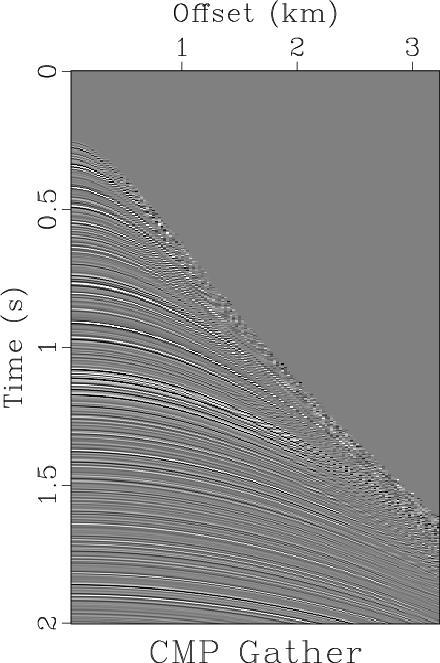
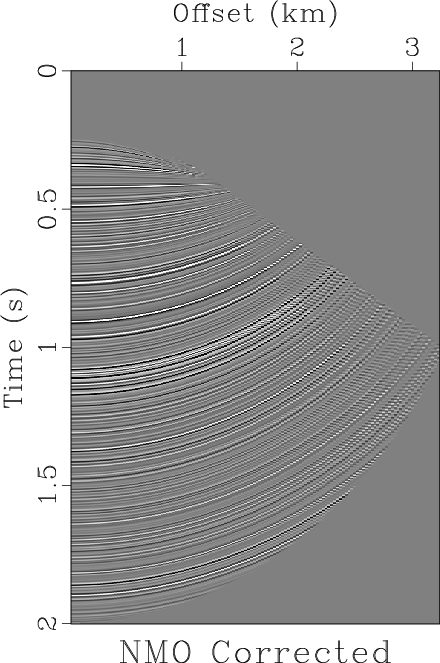
|
|---|
|
cmp2,nmo0
Figure 2. (a) Synthetic CMP gather with 4-ms sampling interval and (b) constant velocity NMO-corrected gather to separate crossing events at far offsets. |
|
|
The convergence of the GMRES algorithm in this example required only 4 iterations to achieve a misfit tolerance
of  . The estimated PWC stack is shown in Figure 3 as a function of iteration, where iteration 0 is the initial model
and iteration 4 is the final estimation result using PWC stack. The conventional stack
results in lower amplitude and lower frequency content, while the PWC stack achieves results similar to the reference trace (Figure 3).
We next compare the frequency content of the PWC stack with the conventional stack (Figure 4a) and the
reference trace (Figure 4b). The conventional stack fails to recover useful frequencies ranging
from 110 Hz to 175 Hz, whereas the PWC stack contains frequencies up to 175 Hz. Using inversion, we
accurately preserve the true amplitude scale and spectrum of the reference trace.
One notable observation is the high frequency information recovered beyond
the Nyquist frequency of the input data (125 Hz). Ronen (1987) justifies the possibility of such recovery with the
idea that a signal can be recovered with the combination of different aliased sequences. Since different offsets
correspond to different propagation paths, we obtain different information from each offset. Therefore,
the combination of all offsets allows us to reconstruct a higher frequency signal that is not limited
by the Nyquist frequency of the input data. In this simple synthetic example, by implementing shaping
regularization, we accurately preserve information in the recovered zero-offset trace with a 1-ms sampling
interval by using input data with only a 4-ms sampling interval.
. The estimated PWC stack is shown in Figure 3 as a function of iteration, where iteration 0 is the initial model
and iteration 4 is the final estimation result using PWC stack. The conventional stack
results in lower amplitude and lower frequency content, while the PWC stack achieves results similar to the reference trace (Figure 3).
We next compare the frequency content of the PWC stack with the conventional stack (Figure 4a) and the
reference trace (Figure 4b). The conventional stack fails to recover useful frequencies ranging
from 110 Hz to 175 Hz, whereas the PWC stack contains frequencies up to 175 Hz. Using inversion, we
accurately preserve the true amplitude scale and spectrum of the reference trace.
One notable observation is the high frequency information recovered beyond
the Nyquist frequency of the input data (125 Hz). Ronen (1987) justifies the possibility of such recovery with the
idea that a signal can be recovered with the combination of different aliased sequences. Since different offsets
correspond to different propagation paths, we obtain different information from each offset. Therefore,
the combination of all offsets allows us to reconstruct a higher frequency signal that is not limited
by the Nyquist frequency of the input data. In this simple synthetic example, by implementing shaping
regularization, we accurately preserve information in the recovered zero-offset trace with a 1-ms sampling
interval by using input data with only a 4-ms sampling interval.
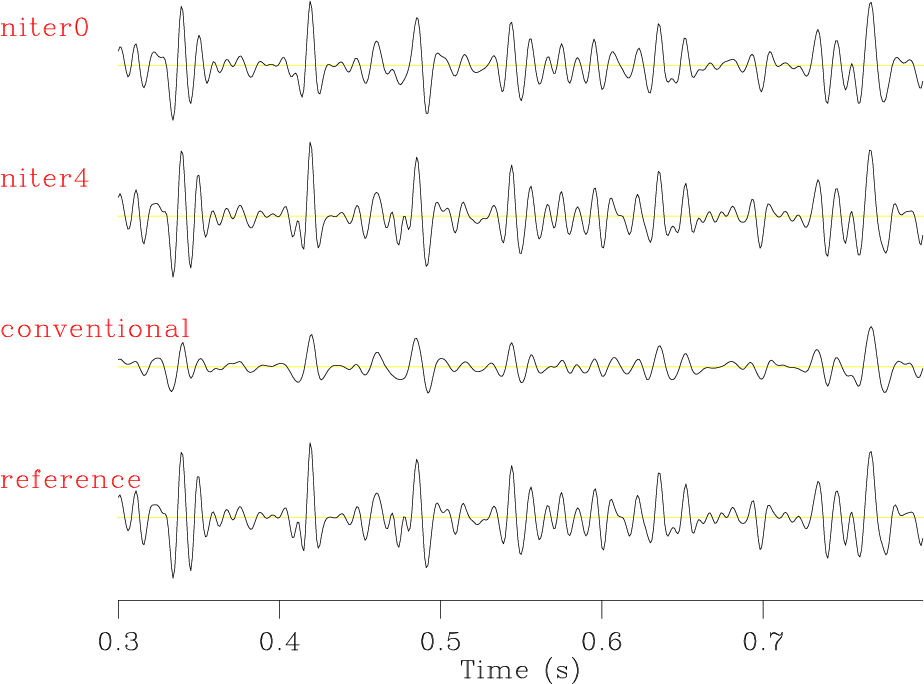
|
|---|
|
niter
Figure 3. Estimated PWC stack as function of iteration using shaping regularization compared with conventional NMO stack and the reference trace. |
|
|
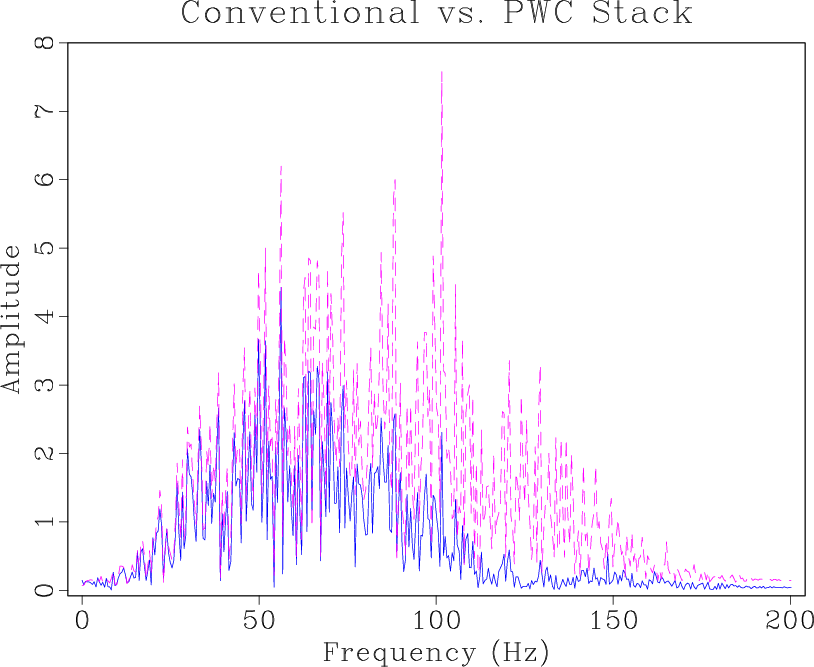
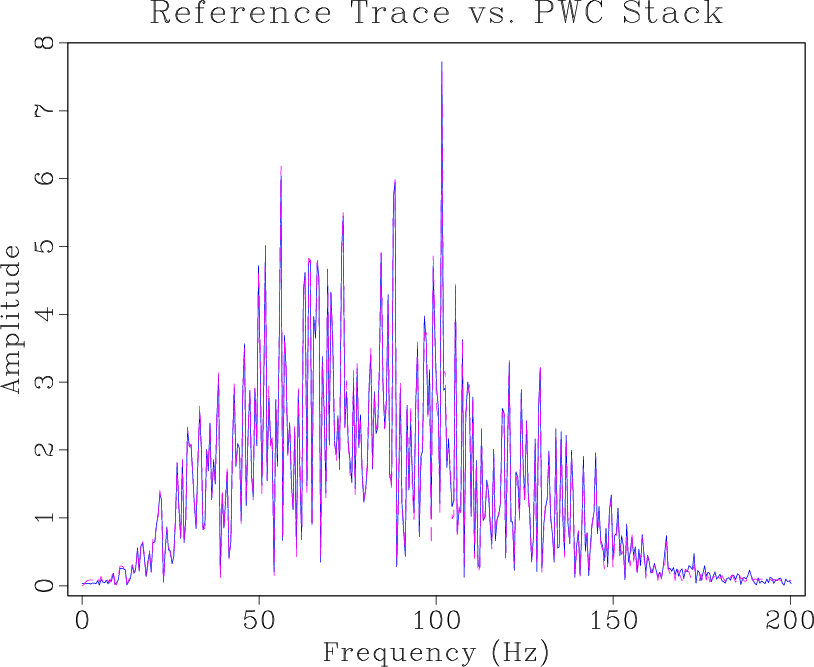
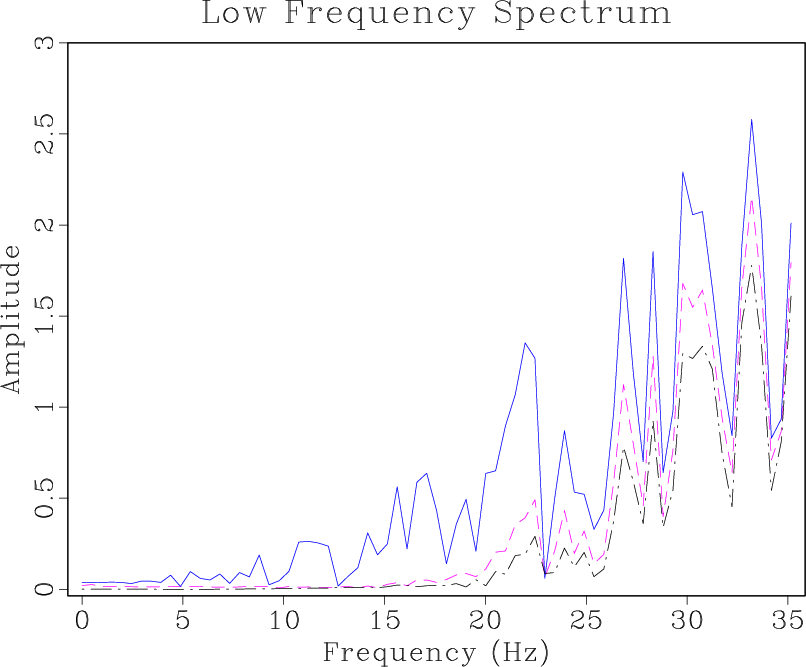
|
|---|
|
spec5,spec6,speclow
Figure 4. Spectral comparison of the PWC stack (dashed magenta) with (a) conventional NMO and stack (solid blue) and (b) the reference trace (solid blue) with a 1-ms sampling interval. (c) PWC stack (dashed magenta) recovers lower frequencies in comparison with the conventional stack (dot dash black) and is consistent with the reference trace (solid blue). |
|
|
Low frequencies play an important role in seismic inversion for velocity and impedance models (Kroode et al., 2013). We next evaluate the algorithm's ability to recover low frequency information in the estimated stack. We apply a low cut filter to the synthetic CMP gather to remove all of the useful low frequencies below 25 Hz. A spectral comparison of the resulting PWC stack to conventional NMO stack and the reference trace is shown in Figure 4c. We zoom in to the low end of the frequency spectrum to see how well each method does in comparison to the reference trace. Conventional NMO stack fails to recover frequencies below 25 Hz, while PWC stack recovers more low frequency information that is consistent with the reference trace.
To demonstrate how PWC stack reduces the effects of “NMO stretch”, we apply this method to each trace of the CMP gather, setting other traces to zero. After repeating this process for all traces in the gather, we concatenate the output PWC stacks to extract the effective NMO. Figure 5a displays the conventional NMO-corrected gather with a stretch mute applied, where far offset information is lost. Figures 5b and 5c compare the NMO-corrected gather before stretch muting to the effective NMO-corrected gather using PWC stacking. The results indicate that the stretching effects that are prominent at far offsets and early times in the NMO-corrected gather without a stretch mute are effectively reduced by implementing PWC stack.
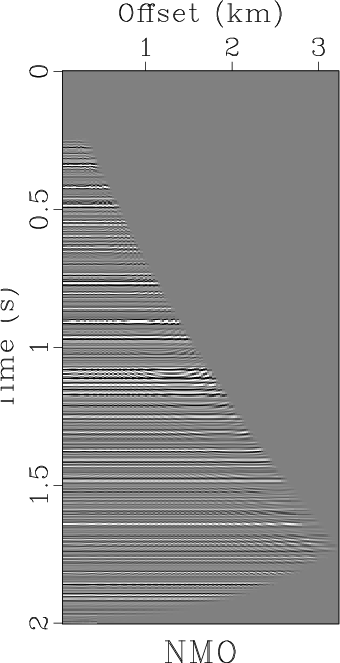
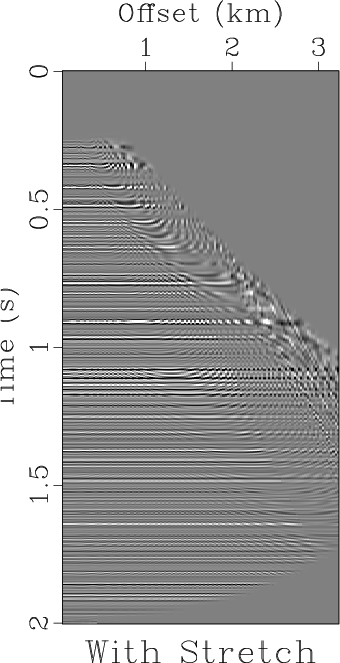
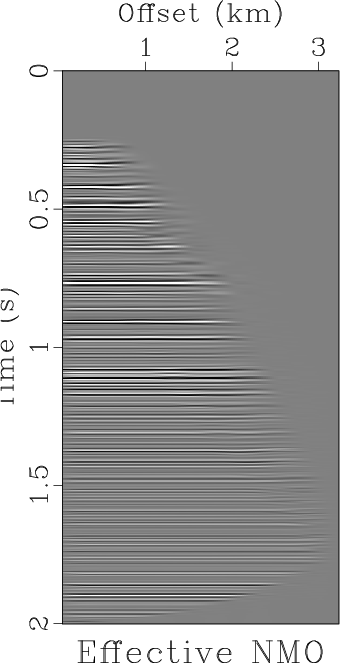
|
|---|
|
nmo3,nmo2,nsnmo
Figure 5. (a) Conventional NMO correction, (b) NMO correction without stretch muting and (c) effective NMO using PWC stack. |
|
|
We next apply this method to a 2-D field dataset from the North Sea and compare the results to conventional NMO stack. This dataset has 1,000 CMP locations and 800 samples per trace with a sampling interval of 4 ms. We use the 4-ms data as a reference for testing the accuracy of our method and subsample the data to 8 ms to provide the input data for PWC stack and conventional NMO stack. The shaping operator used is a bandpass filter ranging from 2 Hz to 100 Hz, which was designed based on the frequency content of the data. The resulting stacked sections are displayed in Figure 6. PWC stack recovers significantly higher frequencies compared to using conventional NMO stack. Thin layers that are unclear in the conventional stacked section become clearly resolved in the PWC stacked section. Overall, events become more continuous and coherent throughout the section using PWC stack, and resolution is noticeably improved.
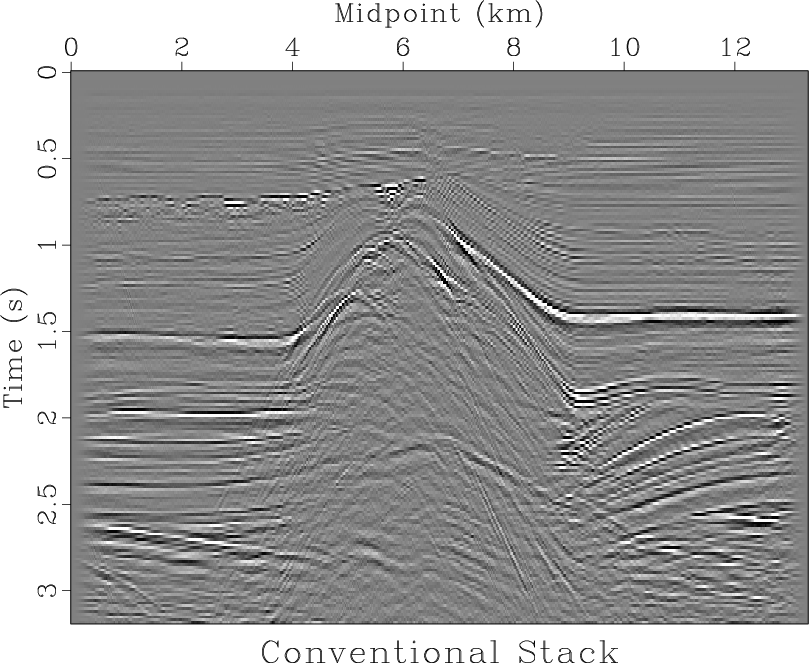
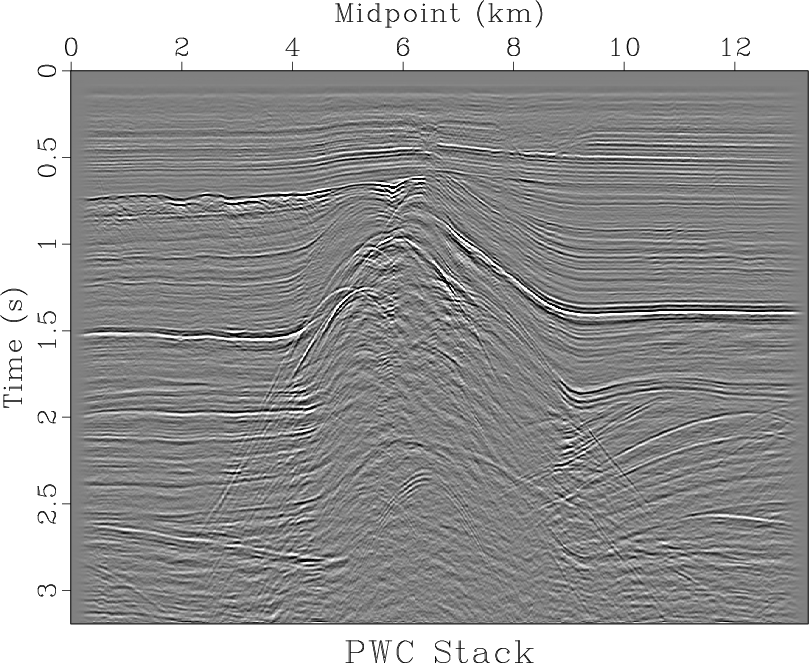
|
|---|
|
istack8,ungmres2
Figure 6. NMO and stack using (a) conventional method and (b) shaping regularization using plane-wave construction. |
|
|